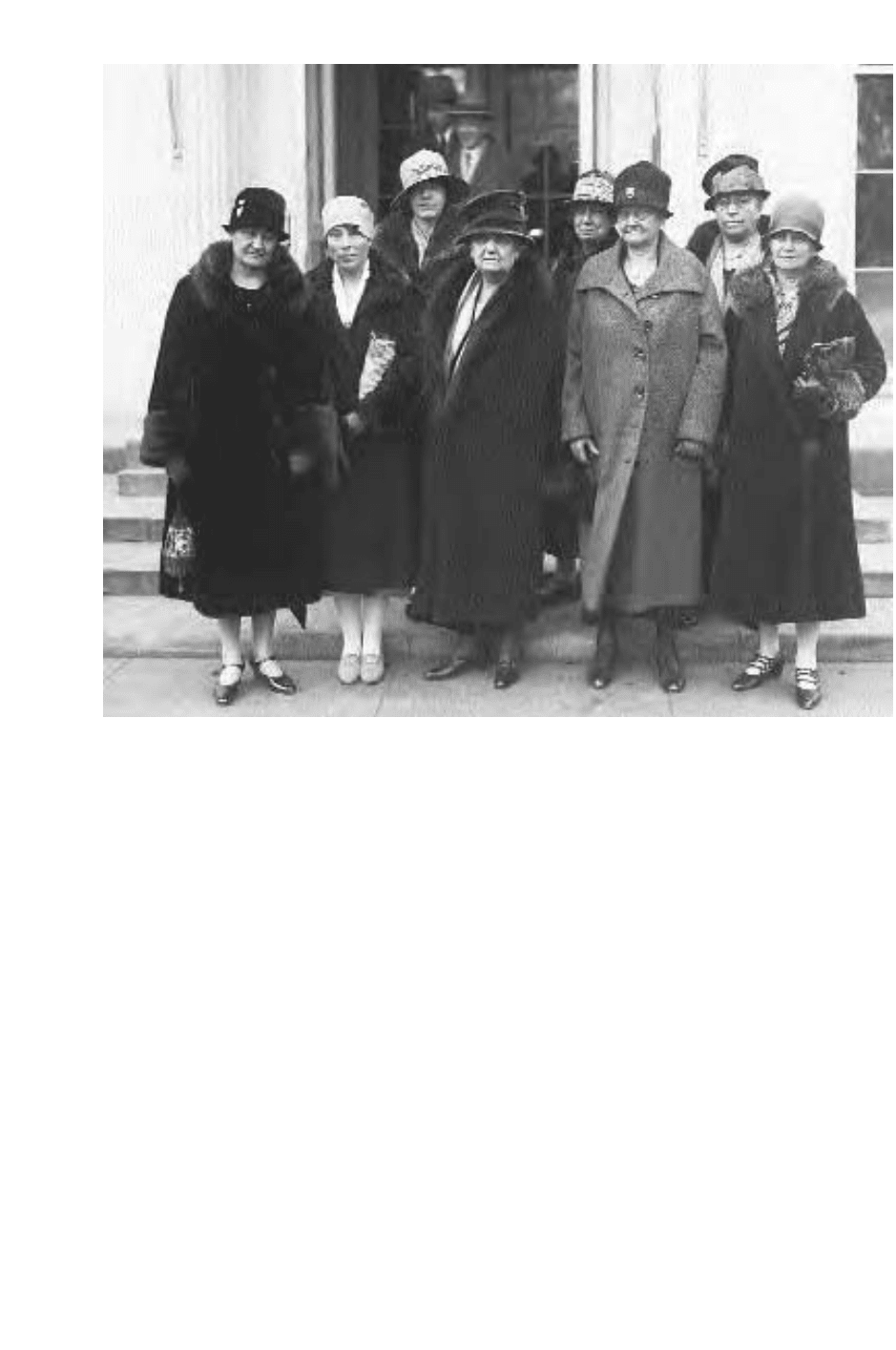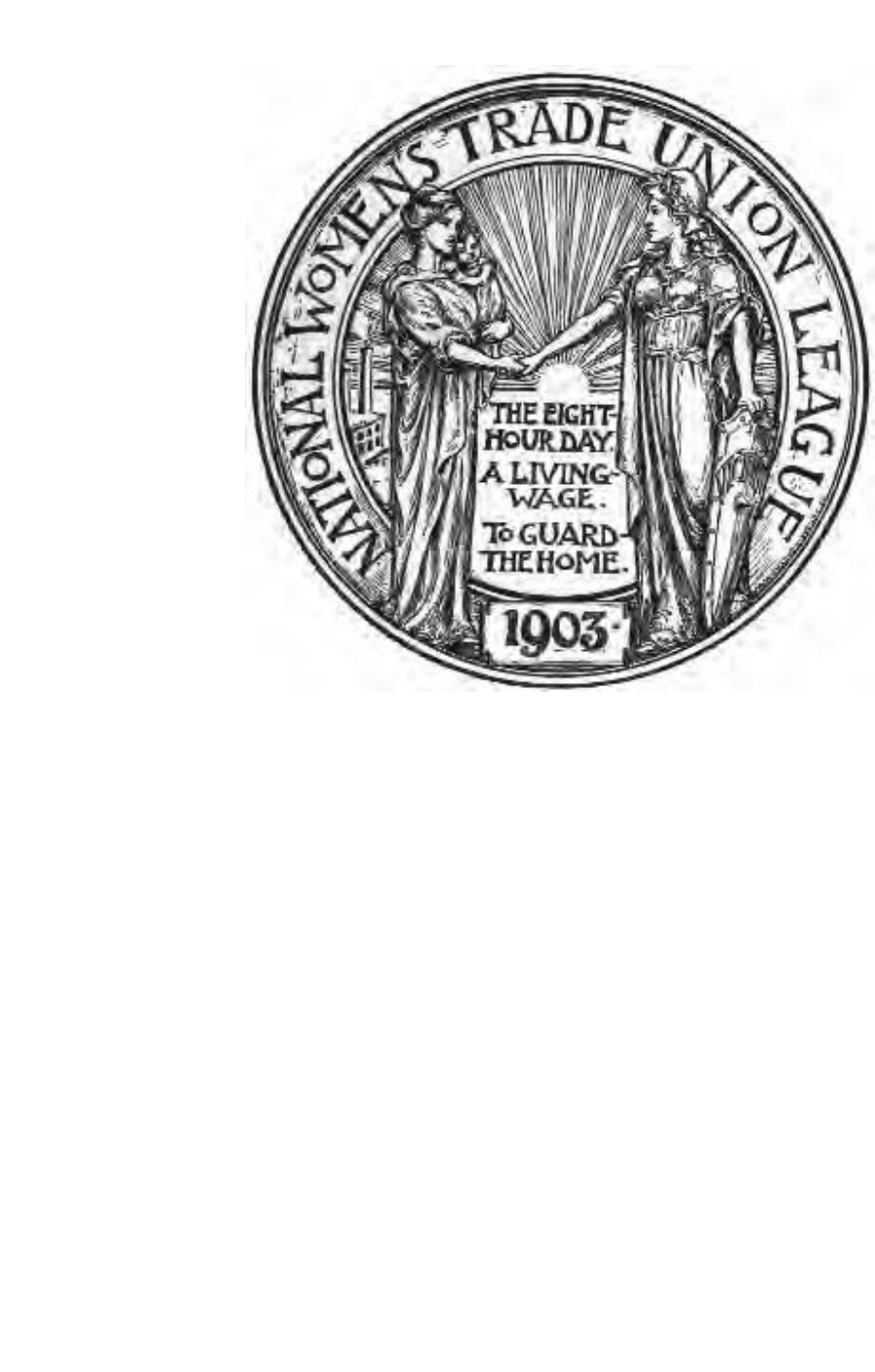Schenken Suzanne O’Dea. From Suffrage to the Senate: An Encyclopedia of American Women in Politics (2 Volumes)
Подождите немного. Документ загружается.


Research conducted by the bureau has helped identify problems con-
fronting working women and has been the basis for its advocacy of several
public policies and the enactment of federal and state legislation. The
Women’s Bureau was instrumental in including women in the Fair Labor
Standards Act of 1938, which for the first time set minimum wages and
maximum hours for women. During World War II, the bureau advocated
nontraditional job training and child care, priorities that continue to the
present. The bureau played a significant role in the creation of the Presi-
dent’s Commission on the Status of Women in 1961 and in the passage of
the Equal Pay Act of 1963.
The bureau’s 1994 Working Women Count! project involved re-
sponses from more than a quarter of a million women. The survey revealed
that women continue to seek equitable pay and benefits, a workplace cul-
ture that supports and respects families, and equal opportunity. In the
1990s, the bureau also conducted a public education campaign on
women’s job rights and created programs to help women balance work and
family needs and to help women move from welfare to the paid workforce.
See also Equal Pay Act of 1963; President’s Commission on the Status of
Women; Women’s Trade Union League
References Freeman, The Politics of Women’s Liberation (1975); www.dol.gov.
Women’s Campaign Fund
Founded in 1974 by a bipartisan group of women, the Women’s Cam-
paign Fund (WCF) was the first organization formed with the specific
purpose of providing financial support for women candidates who sup-
port the Equal Rights Amendment and other women’s issues and are pro-
choice, regardless of party affiliation. WCF began raising money for
women candidates when many of them could not attract financial sup-
port because of their gender. WCF also recruits candidates and provides
training for them.
See also EMILY’s List; WISH List
References Congressional Quarterly, Congressional Quarterly’s Federal PACs
Directory, 1998–1999 (1998).
Women’s Educational Equity Act of 1974
Passed in 1974, the Women’s Educational Equity Act (WEEA) seeks to
provide educational access and opportunities to women and girls. Spon-
sored by Democratic congresswoman Patsy Takemoto Mink of Hawaii,
the WEEA provides funding for the development of nonsexist teaching
materials and for model programs. WEEA encourages full educational op-
portunities for women without the limitations of sex-role stereotypes.
Women’s Educational Equity Act of 1974 709

Part of the Department of Education, the WEEA Office funds gender
equity research, develops model programs and curricula, and implements
policies and programs to address gender bias in schools. WEEA has
awarded more than 700 grants and contracts to schools, universities, com-
munity organizations, and individuals. Some of the grantees include the
National Women’s History Project; the National Women’s Law Center; the
Wichita, Kansas Public Schools; and the National Black Child Develop-
ment Institute.
In the 1970s, the WEEA focused on awareness of gender equity is-
sues, career counseling for women returning to the workforce and to
school, women considering nontraditional occupations, math and science
education for women, and displaced homemakers. In the 1980s, WEEA
added an emphasis on at-risk populations. By the 1990s, its attention had
turned to gender-based violence and school-to-work issues, as well as
providing Spanish translations of its publications and publishing works
focusing on Native American women.
Since 1977, the WEEA has provided funding for the WEEA Equity
Resource Center at the Educational Development Center. The resource
center, a nonprofit educational organization, works with schools, com-
munity organizations, businesses, and individuals. In these cooperative
endeavors, it publishes and markets gender-equitable educational prod-
ucts; fights against discrimination based on gender, race, class, language,
and disability; and distributes multicultural, gender-equitable educational
resources. The center offers classroom materials, program guides, an-
thologies of women’s voices, and other materials.
See also Education, Women and
References www.edc.org/WomensEquity/weeainfo/index.html.
Women’s Equity Action League
The Women’s Equity Action League (WEAL) was founded by Elizabeth
Boyer in 1968 to advocate feminist issues and to be a moderate alternative
to the National Organization for Women (NOW). A founder of NOW,
Boyer shared the organization’s feminist goals but believed that its militant
activities and positions offended moderate Americans. She also thought
that NOW’s support for abortion rights and gay rights alienated many who
supported the equality of women. She left NOW and organized WEAL.
Boyer served as WEAL’s first president and recruited a forty-four-
member board of directors. Rejecting picketing, demonstrating, and vio-
lent or unseemly behavior, WEAL members emphasized working in and
with the political structure. They supported the Equal Rights Amendment
and tax credits for child care, fought against discrimination in tax laws
710 Women’s Equity Action League

and sex bias in the Social Security system, and worked for the appoint-
ment and election of women on the state and local levels. In 1972, WEAL
stopped avoiding the issue of abortion and supported the repeal of laws
regulating and prohibiting abortions.
WEAL’s initial priorities included the elimination of sex-role stereo-
typing in elementary and secondary schools, the promotion of women in
sports, the analysis of credit and banking practices, and a study of divorce re-
form. In 1970, WEAL initiated formal complaints against forty-one univer-
sities and colleges, charging them with sex discrimination in violation of Ex-
ecutive Orders 11246 and 11375. The orders forbid federal contractors from
discriminating on the basis of race, creed, color, national origin, or sex.
WEAL contended that the colleges and universities, as federal contractors re-
ceiving $3.8 billion per year, were subject to the provisions of the order. The
organization pointed to an industry-wide pattern of sex discrimination in
the academic community. In 1974, WEAL began a series of lawsuits against
the U.S. Department of Health, Education, and Welfare to enforce affirma-
tive action policies, particularly in higher education. The resulting decisions
shaped affirmative action policy in education for nearly twenty years. WEAL
also helped open Rhodes scholarships to women. By 1975, WEAL had be-
come a primary political pressure group in the feminist movement.
Other groups adopted priorities and tactics similar to WEAL’s, and
the group disbanded in 1990. The Marguerite Rawalt Legal Defense Fund
continues to offer grants to support legal action in the areas that had been
WEAL priorities.
See also Affirmative Action; Executive Order 11246; Executive Order 11375;
National Organization for Women
References Daniels, “W.E.A.L.: The Growth of a Feminist Organization” (1979);
Freeman, The Politics of Women’s Liberation (1975); Slavin, U.S. Women’s
Interest Groups (1995); Stimpson, ed., Women and the “Equal Rights”
Amendment (1972).
Women’s Health Equity Act
First introduced in 1990 by the Congressional Caucus for Women’s Issues
(CCWI), the Women’ Health Equity Act (WHEA) is a package of pro-
posed bills modeled after the Economic Equity Act. It includes provisions
to create an Office for Women’s Health Research and Development within
the National Institutes of Health (NIH), a gynecology research program
within NIH, and a Center for Women’s Health Research; to require the
NIH director to report on progress on women’s health and research; to set
up a database of research on women’s health; and to require the inclusion
of women and minorities in NIH clinical trials. New versions of the
WHEA are introduced each session of Congress.
Women’s Health Equity Act 711

The proposed act resulted from a General Accounting Office investi-
gation that CCWI had requested. The report documented women’s gen-
eral exclusion from medical research studies conducted by the NIH. One
example of women’s exclusion from health research was the 1988 Harvard
Medical School study that demonstrated that taking one aspirin a day
could help prevent heart attacks. It involved 22,000 subjects, all of them
men. Senator Barbara Mikulski noted: “We have no idea whether that
technique will help women or not. This is blatant discrimination. It is in-
excusable, unforgivable, and we will not allow it to continue.”
CCWI helped pass the Breast and Cervical Cancer Mortality Preven-
tion Act in 1990 to make mammograms and Pap smears more accessible to
low-income women. Two years later, CCWI succeeded in passing the Mam-
mography Quality Assurance Act, establishing federal standards for mam-
mography facilities and requiring their accreditation. Also in 1992, Congress
passed the Infertility Prevention Act, providing screening and treatment for
low-income women of chlamydia and other sexually transmitted diseases
that can make women infertile. Congress passed three more provisions of
the WHEA in 1993, creating the Office of Research on Women’s Health, re-
quiring a biennial report on progress in women’s health research and treat-
ment, and establishing a clearinghouse on research on women’s health.
See also Congressional Caucus for Women’s Issues; Economic Equity Act;
Health Care, Women and; Mikulski, Barbara Ann; Women’s Health, Office of
Research on
References Bingham, Women on the Hill: Challenging the Culture of Congress
(1997).
Women’s Health, Office of Research on
The Office of Research on Women’s Health (ORWH), authorized by Con-
gress in 1993, serves as a focal point for women’s health research at the Na-
tional Institutes of Health (NIH). ORWH has three general mandates: to
increase research into the diseases and other health conditions that affect
women, identify gaps in the knowledge about them, and develop research
priorities; to ensure that women are included in research studies; and to
increase the number of women in biomedical careers.
ORWH works with the scientific and medical community, organiza-
tions interested in women’s health, Congress, and other relevant con-
stituencies. It conducts workshops and seminars to involve the research
community in developing its agenda and priorities. In the late 1990s, its
priority research areas included immunologic and arthritic diseases; acute
and chronic pain; reproductive health; sexually transmitted diseases; gas-
trointestinal disorders; and risk factors for women in different racial, eth-
nic, and socioeconomic groups.
712 Women’s Health, Office of Research on

ORWH cosponsors the Women’s Health Initiative, one of the largest
prevention studies ever conducted in the United States. Focusing on the
major causes of death, disability, and frailty in postmenopausal women, it
will involve over 164,000 women in a fifteen-year study. When completed,
the study will offer information on prevention strategies and risk factors
for coronary heart disease, breast and colon cancer, and osteoporosis.
See also Women’s Health Equity Act
References Bingham, Women on the Hill: Challenging the Culture of Congress
(1997); www.od.nih.gov/orwh/overview.html.
Women’s International League for Peace and Freedom
The Women’s International League for Peace and Freedom (WILPF) was
founded by women active in the international suffrage movement, who be-
lieved that peace required more than treaties between nations and that jus-
tice, freedom, nonviolence, opportunity, and equality were essential com-
ponents of peace. Since its beginnings, WILPF has evolved into an
organization that seeks to create an environment of political, economic, so-
cial, and psychological freedom for all members of the human community.
Women’s International League for Peace and Freedom 713
A petition on
arbitration as a
substitute for war
was presented to
President Calvin
Coolidge at the White
House by Jane
Addams, president
of the Women’s
International League
for Peace and
Freedom, and other
peace activists, 1927
(Corbis/Bettmann)

As World War I raged across Europe in 1915, European and North
American women gathered at The Hague in Holland to register their ob-
jections to the use of violence as a response to conflict, to offer suggestions
to end it, and to identify strategies to prevent war. They created the Inter-
national Committee of Women for Permanent Peace, which changed its
name to Women’s International League for Peace and Freedom after
World War I. In the United States, Jane Addams and Carrie Chapman Catt
had founded the Woman’s Peace Party, which became the U.S. Section of
WILPF. In addition, American Emily Greene Balch was the organization’s
first international secretary. Even though WILPF’s American leadership
included notable and admired women, in the 1920s and 1930s the organ-
ization was suspected of having Communist leanings.
WILPF seeks world disarmament; the end of sexism, racism, class-
ism, and homophobia; and the end of all forms of violence, including
rape, battering, exploitation, and war. WILPF’s mission also includes pro-
moting sustainable agriculture and economic justice within and among
nations. The organization works to fulfill its mission through lobbying,
organizing direct action, conducting and publishing research, and supply-
ing members of Congress and state legislatures with information.
See also Addams, Jane; Catt, Carrie Clinton Lane Chapman; Violence Against
Women Act of 1994
References www.wilpf.org.
Women’s Joint Congressional Committee
Created in 1920 after the passage of the Nineteenth Amendment granting
women suffrage rights, the Women’s Joint Congressional Committee
(WJCC) coordinated the national lobbying efforts of several women’s or-
ganizations. Its areas of interest were protection for infants, public educa-
tion, arms reduction, and protective labor legislation in addition to other
issues concerning women. The WJCC did not take positions on issues. In-
stead it served as a clearinghouse for member organizations, and when
three or more member organizations shared a position on a bill, they
formed a subcommittee to develop and execute a strategy for it. In addi-
tion, a standing committee monitored legislation in Congress.
WJCC’s charter organizations were the American Association of
University Women, American Home Economics Association, Business
and Professional Women/USA, General Federation of Women’s Clubs,
National Congress of Mothers and Parent-Teachers Associations, National
Consumers League, National Council of Jewish Women, Women’s Trade
Union League, and Woman’s Christian Temperance Union. For a time, the
WJCC had twenty-one member organizations.
714 Women’s Joint Congressional Committee

Described in 1922 as the most powerful and highly organized lobby
in Washington, D.C., the WJCC succeeded in passing several of the mea-
sures on its legislative agenda, including the Sheppard-Towner Maternity
and Infancy Protection Act in 1921, the Cable Act in 1922, the establish-
ment of the Women’s Bureau, and the establishment of a federal prison
for women. Research conducted by the WJCC revealed that 60 percent of
civil service examinations were closed to women. WJCC worked with a
woman on the Civil Service Commission, ended the discrimination, and
then passed a measure that reclassified civil service positions to establish
pay equity among them. The WJCC’s support for the Child Labor
Amendment helped gain its approval in Congress, but not enough states
ratified it. Because of its support for protective labor legislation, the
WJCC opposed the Equal Rights Amendment and succeeded in prevent-
ing it from gaining congressional approval. In areas less directly related to
women, WJCC also supported the establishment of a coal commission
and passage of the 1921 Packers and Stockyards Control Act.
In the mid-1920s, leaders in several of the member organizations
were accused of having Communist connections. These and other allega-
tions of a spider web of Communists among women’s organizations con-
tributed to the WJCC’s loss of influence and its dissolution in the early
1930s.
See also American Association of University Women; Business and Professional
Women/USA; Cable Acts; Child Labor Amendment; General Federation of
Women’s Clubs; National Consumers League; National Council of Jewish
Women; Sheppard-Towner Maternity and Infancy Protection Act of 1921;
Spider Web; Willebrandt, Mabel Walker; Woman’s Christian Temperance
Union; Women’s Bureau; Women’s Trade Union League
References Breckenridge, Women in the Twentieth Century: A Study of Their
Political, Social, and Economic Activities (1933); Brown, American Women in
the 1920s: Setting a Course (1987); Lemons, The Woman Citizen (1973).
Women’s Liberation Movement
In the 1960s, groups of young women in Chicago, Toronto, Seattle, and
other cities formed spontaneously and independently of each other.
Some of the women had experience in the civil rights movement in the
South and others in radical movements in the North, but they shared a
common interest in ending male dominance and in fundamentally re-
shaping society. For example, after concluding that hierarchies are a male
form of organization, they developed nonhierarchical groups with equal
relationships. They agreed that no one would be a leader or an achiever,
and they would resolve differences through discussion. The groups
adopted consciousness raising as a technique for revealing sexism to
Women’s Liberation Movement 715

themselves and each other and developed theories regarding male domi-
nance and sexism.
Women’s liberation groups differed from organizations like the Na-
tional Organization for Women (NOW) in several ways. NOW, for exam-
ple, works to gain power for women in the existing social, political, and
economic systems. Women’s liberation adherents rejected those structures
and sought to create a new, egalitarian, unstructured society. They re-
jected men’s participation in their groups and explored lesbian relation-
ships as purely feminist relationships. Many of their ideas were initially
viewed as radical or undesirable by more staid feminists, but over time the
ideas gained acceptance within the larger feminist movement. By the mid-
1970s, women’s liberation groups had dissolved.
See also Feminist Movement; New York Radical Women; Radicalesbians;
Redstockings
References Davis, Moving the Mountain: The Women’s Movement in America
Since 1960 (1991).
Women’s Policy, Inc.
Founded in 1995, Women’s Policy, Inc. (WPI) provides nonpartisan re-
search and information to policymakers, advocates, and the public on is-
sues important to women and children. Through a weekly newsletter,
briefing papers, and an annual summary of legislation affecting women
and families, WPI reports on abortion, affirmative action, women’s health
issues, violence against women, and economic equity for women. Other
issues covered include workplace fairness, women’s entrepreneurship,
family-friendly work policies, child care, and child support enforcement.
Two former staff members of the Congressional Caucus on Women’s
Issues formed WPI after the U.S. House of Representatives abolished
dozens of legislative service organizations, including the caucus.
See also Abortion, Affirmative Action; Child Support Enforcement; Economic
Equity Act; Health Care,Women and; Pay Equity
References http://orgs.womenconnect.com.
Women’s Political Council
Founded in 1946, the Women’s Political Council (WPC) played a critical
role in the 1955 Montgomery, Alabama, bus boycott and helped launch
the civil rights movement of the 1960s. The WPC had threatened a boy-
cott of the city’s buses since 1950, and Rosa Parks’s refusal to give up her
bus seat and subsequent arrest provided the catalyst to spark the boycott.
Under the leadership of the WPC, the boycott began four days after her
arrest and lasted for more than a year.
716 Women’s Policy, Inc.

A group of well-educated African American women had formed WPC
after the Montgomery branch of the League of Women Voters (LWV) re-
fused to admit black women members. About forty women decided to cre-
ate the WPC to provide themselves with a means to be politically active, fo-
cusing their efforts on fighting racial segregation and improving the lives of
all African Americans, particularly women and children. To achieve its
goals, WPC sponsored a variety of programs, including Negro Youth Day,
which sought to inspire African American youth to become leaders and to
believe in the possibility of change through electoral politics. Several of the
students trained in WPC programs became leaders in the Student Nonvio-
lent Coordinating Committee, registering voters in Mississippi and other
states in the Deep South. The organization also organized letter-writing
campaigns, taxation protests, and meetings with the mayor.
As the news circulated that Rosa Parks had been arrested on 1 De-
cember 1955, WPC leader JoAnn Robinson, head of the English depart-
ment at Alabama State College in Montgomery, used the college’s mimeo-
graph machines to print leaflets calling for a bus boycott. Other WPC
members went into action, distributing the leaflets and organizing sup-
port for the boycott, which began on 5 December and involved almost all
African Americans in the community. Robinson continued to use the col-
lege’s mimeograph machines throughout the boycott, which provided a
vital means of communication, despite the fact that she risked her job and
her safety by doing it. Although she attempted to keep her role as invisi-
ble as possible, she was among the first arrested as a result of the boycott
and later lost her teaching position for her activism.
After members were subpoenaed during the trials relating to the
boycott, they destroyed the organization’s records out of fear that the in-
formation would be subpoenaed and the meeting minutes and member-
ship lists publicized, resulting in retaliation against them. WPC dissolved
in 1960 as members lost their jobs, feared being fired or being subjected
to other forms of retaliation, and discontinued their activism. The re-
maining core continued the work through churches.
See also Civil Rights Movement, Women in the; Parks, Rosa Louise McCauley
References Barnett, “Black Women’s Collectivist Movement Organizations:
Their Struggles during the ‘Doldrums’” (1995).
Women’s Political Union
Founded by Harriot Stanton Blatch, the Women’s Political Union (WPU)
began as the Equality League of Self-Supporting Women (ELSSW), a
group that Blatch established in 1907 to revitalize the woman suffrage
movement. Through the ELSSW, Blatch organized working women from
the ranks of doctors, lawyers, milliners, and industrial workers, women
Women’s Political Union 717

who were generally overlooked by the National American Woman Suf-
frage Association (NAWSA), the dominant suffrage organization. To help
attract working-class women, ELSSW concentrated on their needs; in ad-
dition, it did not have membership fees. Through the ELSSW, for exam-
ple, trade union women testified before the New York legislature in sup-
port of woman suffrage, the first time working-class women had done so.
ELSSW changed its name in 1910 to the Women’s Political Union to in-
clude a broader range of women. Considered a radical organization, the
WPU held open-air meetings and outdoor parades and sought newspaper
publicity, strategies later adopted by the more conservative NAWSA. The
WPU merged with the Congressional Union in 1916.
See also Blatch, Harriot Eaton Stanton; Congressional Union; National
American Woman Suffrage Association
Women’s Trade Union League
Founded in 1903 to help working women organize, the Women’s Trade
Union League (WTUL) obtained support primarily from wealthy women.
The WTUL did not achieve its goal of persuading women to join unions,
but it succeeded in other areas. It publicized women’s low wages, long
718 Women’s Trade Union League
The logo of the
Women’s Trade
Union League, at a
convention in New
York City, 1924
(Courtesy: University
of Florida,
Gainesville)
